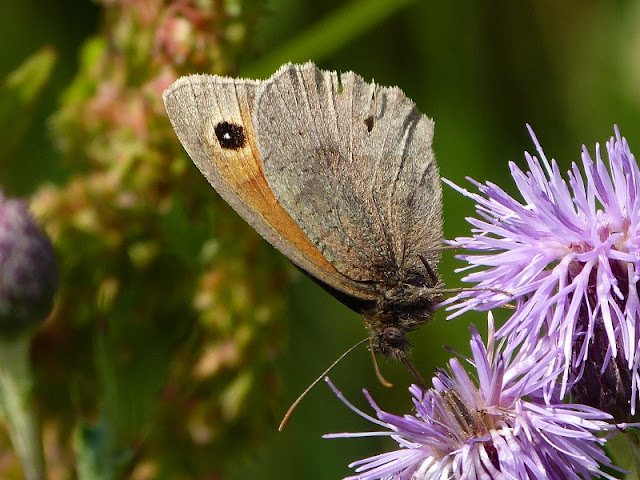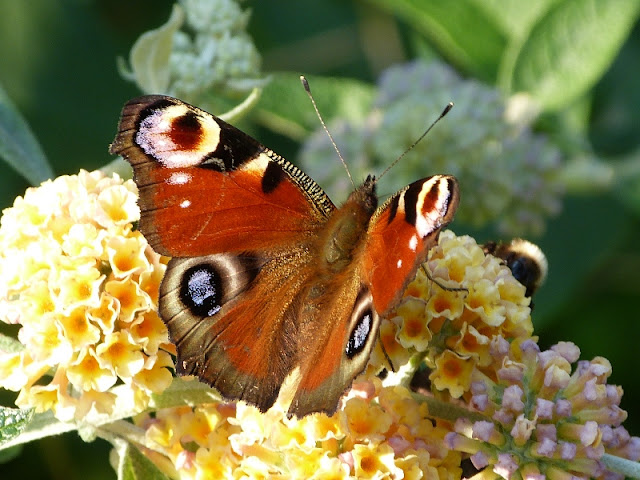Continuing on from my previous post ...
Ringlets started to appear on the 6th June, which is the earliest I have known over the last ten years. They did well and had a longer than normal season. Normally they are only around for seven to nine weeks, but in 2021 they were recorded over 11 weeks.
Large Skippers were another 2021 success story. Having first been recorded in East Lothian in 2014, they made slow progress westwards along the foothills of the Lammermuirs. Over the intervening years I only received a handful of records of them. In 2021 I received 11 records, many of which were from Levenhall Links. There was also a record from John Muir Country Park and the Lammermuir Hills.
Meadow Browns had an amazingly good year. In fact I received more records of them in 2021 than in any previous year, which is great because I had been worried that numbers had been declining over the last few years. The first record was on 16th June. Interestingly they had quite a short season with the last record coming in on the 1st September.
The Small Skipper had an exceptional year. Their numbers have increased year on year since they were first discovered in East Lothian in 2011. The first record was received on 17th June, which is a week earlier than in previous years, and I received records of 1643 Small Skippers, more than three times the average of the last few years.
The first record I received of a Dark Green Fritillary was on 21 June. These butterflies also had a very good year and I received more records of them than in any previous year.
It is interesting to note that the species that emerged from May onwards did very much better than the species that emerged earlier in the year. I can only put this down to the cold weather we had in the late spring.
There were a number of other species recorded in East Lothian in 2021. Some of them are regularly seen, but only in small numbers and others are rare migrants.
We had a few sightings of Green Hairstreaks in May from two sites. They are known to occur in a few different locations, but they are mostly remote and difficult to access. It is likely that there are a lot more of them around than we are aware of.
On 5th June there was a sighting of a Clouded Yellow flying along the coast at Longniddry. They are occasionally recorded in East Lothian and are migrants that have ventured north from mainland Europe.
The only Small Pearl-bordered Fritillary I am aware of in East Lothian in 2021 was one that I saw in the Lammermuirs on 29th June. They are a very rare butterfly in East Lothian, only having been recorded from a couple of sites.
Another exciting butterfly seen in East Lothian was the Brimstone. In fact there were four of them seen in 2021, two in June, one in July and one in August, all in different locations across the county. They are seen once or twice every few years and are considered to me migrants from England. Their distribution matches the distribution of the caterpillar food plant, Alder Buckthorn, which doesn't occur naturally in Scotland. However, it is interesting to speculate whether there could be a colony of Brimstones somewhere in an East Lothian garden.
I usually say that there are four known colonies of Northern Brown Argus in East Lothian. Two of these locations are really small and I fear that the colonies may have died out in them. There are, however, two strong colonies at either end of the Lammermuir Hills and I was pleased to hear that they have also been found in a location close to Traprain Law. It is difficult to assess how well they are doing with so few records. I saw some on 29th June and I heard of one other being seen on 24th July.
There were only three records of Graylings this year between 29 June and 14th July, all from the same site. I only know of three sites where they occur in East Lothian, one in the east of the Lammermuirs, one in the middle of the housing development at Blindwells and on the pyramid at Meadowmill. Sadly there were no records from the new site we have created for them at Levenhall Links.
A very rare sighting, accompanied with a photograph, of a Camberwell Beauty was reported on 14th September in North Berwick. I am only aware of two other sightings in East Lothian in the last 40 years, one in 2019 and the other back in 1984.
This last butterfly meant that we recorded 27 species of butterflies in East Lothian in 2021. I think this must be a record for the county. Over the last 50 years we have seen an increase in the number of species that breed in East Lothian, most of these species are extending their range northwards, apparently in response to climate change. In 2021 we also had three unusual visitors.
I would like to extend a big thank you to everyone who has sent in records over the last few years. This has helped to build up a great picture of how butterflies are doing in East Lothian. Every record makes a big difference, no matter how common you think the species is, or how insignificant a single record may appear. I was in touch with Butterfly Conservation a few years ago and they said that it is just as important to send in records of common species as it is for an exciting rarity. Otherwise in the future people may consider that green-veined Whites or Meadow Browns used to be uncommon.
I am looking forward to hearing about the first butterfly of 2022.



















